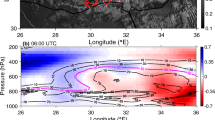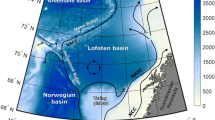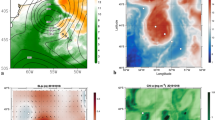Abstract
Southern Ocean (SO) air is amongst the most pristine on Earth, particularly during winter. Historically, there has been a focus on biogenic sources as an explanation for the seasonal cycle in cloud condensation nuclei concentrations (NCCN). NCCN is also sensitive to the strength of sink terms, although the magnitude of this term varies considerably. Wet deposition, a process encompassing coalescence scavenging (drizzle formation), is one such process that may be especially relevant over the SO. Using a boundary layer cloud climatology, NCCN and precipitation observations from Kennaook/Cape Grim Observatory (CGO), we find a statistically significant difference in NCCN between when the upwind meteorology is dominated by open mesoscale cellular convection (MCC) and closed MCC. When open MCC is dominant, a lower median NCCN (69 cm−3) is found compared to when closed MCC (89 cm−3) is dominant. Open MCC is found to precipitate more heavily (1.72 mm day−1) and more frequently (16.7% of the time) than closed MCC (0.29 mm day−1, 4.5%). These relationships are observed to hold across the seasonal cycle with maximum NCCN and minimum precipitation observed during Austral summer (DJF). Furthermore, the observed MCC morphology strongly depends on meteorological conditions. The relationship between NCCN and precipitation can be further examined across a diurnal cycle during the summer season. Although there was again a negative relationship between precipitation and NCCN, the precipitation cycle was out of phase with the NCCN cycle, leading it by ~3 hours, suggesting other factors, specifically the meteorology play a primary role in influencing precipitation.
Similar content being viewed by others
Introduction
The atmosphere over the Southern Ocean (SO) is renowned for being the most pristine on Earth1,Full size image
To further investigate the meteorological differences under open and closed MCC, we also examined their composite soundings using ERA5. As shown in Fig. 2, closed MCC (Fig. 2a) exhibits a stronger inversion consistent with the higher EIS in Fig. 1d. On the other hand, open MCC (Fig. 2b) displays a higher inversion altitude, which is typically associated with conditions favorable for enhanced precipitation57.
Seasonal variations in the CCN-precipitation relationship
Although we have less than six complete years of all observations, it is of interest to examine the seasonal cycle of these records (Table 3), in an effort to investigate the role of precipitation in this cycle. Turning first to the median baseline NCCN, we observe a strong seasonal cycle with an Austral summer (DJF) maximum of 157 cm−3 and a winter (JJA) minimum of 54 cm−3, which is consistent with the long-term CGO records20,21,28,29,34,37,69,70. The average baseline precipitation rate and frequency exhibit a pattern opposite to that of median NCCN, with a maximum in winter (2.69 mm day−1 occurring 20.3% of the time) and a minimum in summer (0.68 mm day−1 occurring 6.4% of time). We note that the average baseline precipitation rate (1.69 mm day−1) substantially contributes to the overall precipitation rate across this latitude band (2.5–3.2 mm day−1)48, which is found in various precipitation products48. Statistical independent sample tests, including two-tailed Student’s t test and Whitney U test, were conducted to assess the significance of the observed differences in NCCN and precipitation. These tests aimed to test the null hypotheses that there is no difference in NCCN and precipitation across the seasons. The results confirmed that these differences are statistically significant (p < 0.05), reinforcing the validity of our findings.
After segregating the records into open and closed MCC cases, we observe an inverse tendency between NCCN and precipitation when we analyze the data across different seasons (except for the closed MCC during the winter, which can be attributed to the limited number of cases with precipitation from closed MCC during this season). Further we find that for all seasons, open MCC has a greater average precipitation rate where it is more frequent as well and lower median NCCN compared to closed MCC (Table 3). The relative difference in median NCCN is least in summer (12%) and greatest in winter (27%). The most pristine air is observed at CGO when open MCC is present upwind during the winter season. Using the statistical tests (including two-tailed Student’s t test and Whitney U test), we tested the null hypotheses that there is no difference in NCCN and precipitation between open and closed MCC across different seasons, which confirm the significance of these differences (p < 0.05).
We further note a strong seasonal cycle in the frequency of coverage of open MCC with a wintertime peak of 30.7% of all baseline records and a summertime minimum of 6.2% (Table 3). Such a seasonal cycle is consistent with numerous climatological studies (e.g.60,68). Conversely no substantial seasonal cycle is evident in the frequency of occurrence of closed MCC (Table 3).
Using HYSPLIT back trajectories we sought to establish whether differences in the air mass origin could be linked to differences in NCCN, and potentially cloud morphology. The 72-h back trajectories (Fig. 3), however, are not conclusive with only weak differences between seasons and between the open and closed MCC. Immediately upwind of Tasmania, back trajectories of closed MCC predominantly come from the west, while open MCC trajectories have mostly a south-westerly origin. During winter, open MCC back trajectories tend to originate at higher latitudes than closed MCC. Also, for closed MCC during winter, there is an interesting air mass origin region in the Australian Bight, near the coast. The average NCCN for these scenes was similar to overall average. In general, the baseline air masses originate from higher latitudes, as previously established. Only rarely do these back trajectories cross over Antarctica. The vertical component of these back trajectories (Fig. 4) suggests that large-scale subsidence prevails for both open and closed MCC, somewhat stronger for closed MCC. Back trajectories of open MCC in winter show considerably more spread through the boundary layer, suggesting a well-mixed boundary layer due possibly to active shallow convection. There is less spread in the vertical history of closed MCC back trajectories, consistent with widespread subsidence.
Vertical motion along the average back trajectory (solid line) of the 24-h back trajectories of air parcels at a height of 1000 m, for cases where more than 80% of the baseline with a radius of 100 km in 3 h averaging time, was covered by open MCC (top) and closed MCC (bottom) for Austral summer (left) and winter (right) (2016–2021).
An alternate hypothesis for the cause of the observed seasonal cycle in open MCC and precipitation at CGO pertains to the annual migration in the subtropical ridge, which reaches its highest latitude (38° S) along Australia during February with an average intensity of 1016 hPa71. During winter the subtropical ridge strengthens in intensity but retreats to lower latitudes (28° S) over the Australian continent. Manton et al.48 found a strong correlation coefficient (~−0.6) between precipitation and MSLP across the SO, highlighting the importance of the general circulation in precipitation processes.
The seasonal cycles of atmospheric stability parameters were analyzed (Table 4) to further assess their relationship to the baseline conditions and cloud morphology. These parameters are important for determining the depth of the MABL and evolution of low clouds61, which are a major source of precipitation in many regions. Lang et al.72 also found a connection between EIS and the occurrence of precipitation over Macquarie Island. Both M and EIS show a seasonal cycle with stronger stability (lower M and higher EIS) during summer (DJF), consistent with Lang et al.72 and McCoy et al.61. Also, there is a stronger inversion (61% greater EIS) under closed MCC coverage, consistent with the composite sounding (Fig. 2a). Thus, these meteorological controls may be of further importance in setting the seasonal cycle of precipitation, which may also contribute to the seasonal cycle of NCCN.
In order to evaluate the importance of wet deposition in the evolution of the CCN budget from closed to open MCC across the SO, we sought to employ a quantitative approach. Previous studies have noted the importance of precipitation in the transition from closed to open MCC64,66,73 and the hypothesis is that wet deposition will clean out the MABL by removing particles. Kang et al.43 utilized the recent summertime Clouds Radiation Aerosol Transport Experimental Study (SOCRATES) campaign over the SO to drive the CCN budget model developed by Wood et al.42. This model considers various source and sink terms, including entrainment of CCN from the free troposphere (NFT), primary production at the sea surface from sea-spray (Ns) and precipitation that is induced by coalescence scavenging (Np)7,42,43. Kang et al.43 assumed the system was at steady state and found that the CCN budget was most sensitive to the NCCN of the overlying free troposphere compared to other sources. Coalescence scavenging was also found to be an important sink.
Following Kang et al.43, we also employed the CCN budget model along with available datasets to perform a CCN budget analysis. Considering the relatively constant NFT and Ns during the summer when moving between open and closed MCC (as suggested by Kang et al.43), we can assume that
This equation suggests that the reduction in NCCN from closed to open MCC can be attributed to precipitation along the trajectory. The precipitation sink term depends upon the following terms74:
where PCB represents the precipitation rate at cloud base, K = 2.25 m2 kg−1 is a constant that depends on the collection efficiency of cloud droplets by drizzle drops, h is the cloud thickness and zi is the depth of the MABL74. Due to the lack of cloud base precipitation measurements in our datasets, we use surface precipitation data as a proxy for PCB. Cloud thickness and boundary layer height are estimated using the composite ERA5 soundings.
Our calculations indicate that it would take approximately 3 h for precipitation during the transition from closed to open MCC to remove the 12% median CCN differences between closed (165 cm−3) and open MCC (145 cm−3) during summer. It should be noted that this estimate is defined by constraints in our calculation. Extending such quantitative analysis to other seasons is limited by a lack of enough observational information (e.g., the NFT and Ns). Nonetheless, our expanded budget analysis for other seasons indicates transition time within the range of 2–6 h. Another limitation of this analysis pertains to the estimation of precipitation that is induced by coalescence scavenging (Np), which relies on the precipitation rate at the cloud base level74. Our measurements, however, are only available at the surface. Recent research by Kang et al.75, found substantial differences between precipitation rates at the cloud base and the surface for MABL clouds over the SO using in situ and airborne cloud radar observations. K, which has been used in estimating Np, is also subject to uncertainty. Nevertheless, these limitations highlight the significance of future coordinated efforts, such as multi-platform measurement campaigns in this region to supply critical datasets needed for cloud-aerosol-precipitation research, including a more comprehensive CCN budget analysis.
Meteorological influences on diurnal precipitation
Moving beyond the seasonal cycle, we can also explore potential relationships between the median NCCN and precipitation at the diurnal time scale, aiming to understand whether CCN acts as the driver of the precipitation, or vice versa. We limit this analysis to the summer season, when solar forcing is most intense and can readily decouple, thin and even completely burn off MABL clouds76,77. The Lang et al.68 cloud climatology readily found such a diurnal cycle in closed MCC over the latitude band between 40° to 50° south. For this analysis, however, we employ all baseline samples (open, closed and other) to increase the sample size and ensure a sufficient amount of data for analysis and to clearly illustrate the diurnal cycle. Furthermore, in order to adequately assess the diurnal cycle, data for precipitation and NCCN from 2011 to 2015 has been included in this analysis (both data were not available before 2011). Looking first at the precipitation (Fig. 5b, c), a strong diurnal cycle is evident in both mean precipitation rate and frequency with a peak in the early morning (5 AM local time) and a minimum in the afternoon. It should be mentioned that the 25th and 75th percentile of precipitation were not presented as both values were zero during the summer. Lang et al.72 and Tansey et al.58 found a similar diurnal cycle in precipitation over Macquarie Island. The median NCCN at CGO (Fig. 5a) also displays a diurnal cycle, contrasting with the precipitation pattern with a peak concentration observed at 8 PM. Ayers and Gillet20 and Ayers et al.69 also found a diurnal cycle for NCCN over the CGO. Wider research suggests that the thinning of the marine boundary layer clouds through solar forcing/burn off is likely to be driving the diurnal cycle of the precipitation rate72,78. Additionally, we observe a diurnal cycle in MSLP (Fig. 5d) and the two stability parameters (M and EIS) (Fig. 5e, f). These meteorological conditions, particularly the stability of the atmosphere and related dynamics, are likely other drivers of the observed diurnal cycles in precipitation. It is especially intriguing to note that the minimum of MSLP coincided with the peaks of precipitation frequency and intensity. These findings further emphasize the crucial role of meteorological controls on ACPI.
In our effort to examine the meteorological impacts on ACPI behaviors, we employed multilinear regression to examine the relationship between meteorological factors, precipitation and aerosol. Subsequently, we removed the meteorological influences on precipitation and NCCN and examined the residuals. Notably, our findings indicate that, after controlling for the meteorology, the correlation between precipitation and NCCN decreased from −0.045 to −0.034 (see details in the attached supplementary materials), suggesting that a substantial portion of the relationship between precipitation and CCN is explained by meteorological factors. Additionally, we conducted a comprehensive analysis comparing multilinear regression models of precipitation with and without considering CCN, revealing minimal differences in R² values and correlation coefficients (see details in the attached supplementary materials). This underscores the limited influence of CCN on precipitation, emphasizing the substantial role played by meteorological factors in sha** their relationship. It is important to note that our findings do not imply that the role of CCN is negligible, especially in a changing climate. Even minor influences from the CCN could have important effects on climate given the complexity of the climate system.
Importantly we note that the diurnal cycle in precipitation leads the small diurnal cycle in CCN by roughly 3 h (Fig. 5). To test the significance of this time lag, we applied the Bootstrap** method by which 10000 samples were randomly drawn with a sample size of 8000 (from a total of 8200-time steps). The results indicate that in over 98% of the instances, the minimum NCCN occurred after the maximum precipitation (in just 2% of the instances, the minimum NCCN preceded the maximum precipitation). This suggests that the diurnal cycle in precipitation is unlikely to be led by CCN (with a confidence level of 98%). These analyses emphasize that multiple factors, particularly the meteorology, are likely at play in sha** the diurnal patterns of precipitation, and the influence of CCN on precipitation is not a dominant mechanism over our study area. Again, further investigation is needed to explore how precipitation may be influencing the diurnal cycle of CCN through processes like wet deposition, but it is clear that the relationship between CCN and precipitation is complex.
Overall, this analysis once again suggests that a greater understanding of the sinks of aerosols is required to more accurately close the CCN budget across the SO. Specifically, this analysis highlights the potential importance of precipitation in this regard, and the role of the large-scale circulation in driving precipitation across this region.









